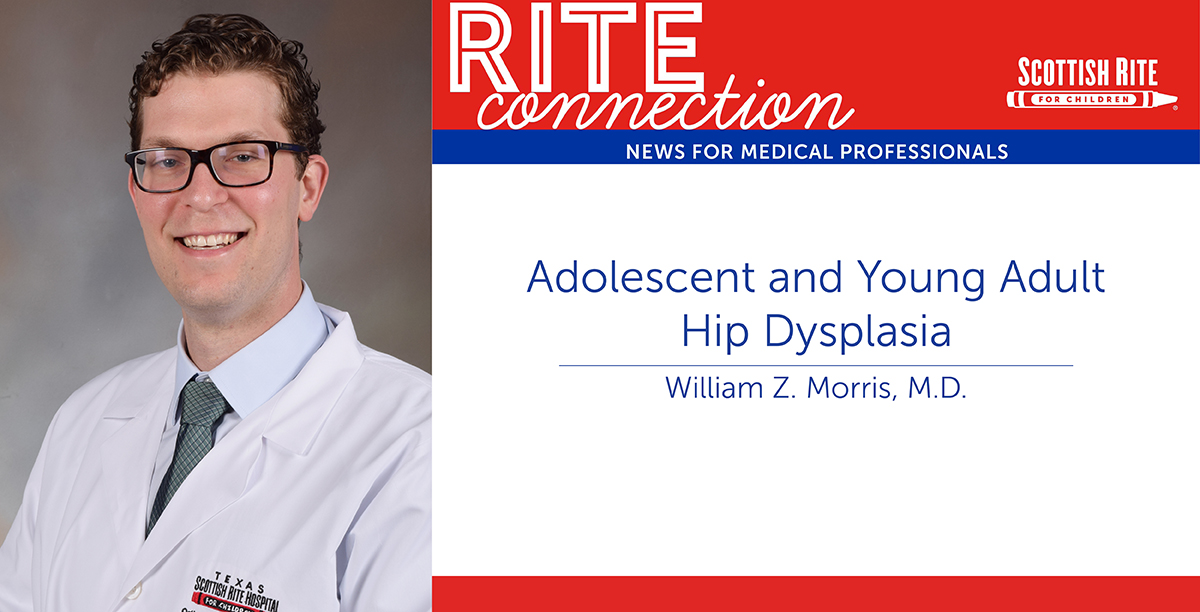
Oct 15, 2020 / Hip Disorders
Adolescent and Young Adult Hip Dysplasia
Kids of all ages complain of aches and pains. But it is important to understand the specifics of those complaints to determine whether it is due to a common growing pain or because of something more serious.
For adolescents and young adults, activity level can vary – whether too much or too little. Each can cause the occasional hip pain. However, not all hip pain can be ignored. Identifying certain hip conditions early in presentation can prevent long-term issues as the adolescent grows into adulthood.
In a normal, healthy hip, the ball (femoral head) is fully covered by the socket (acetabulum). It provides stability and broadly distributes the forces of weight-bearing. Hip dysplasia occurs when the socket is shallow and does not cover the ball as well as it should. This leads to increased forces from weight bearing over a smaller area of cartilage and can cause hip pain and potentially accelerate early arthritis.
Despite early screening efforts by pediatricians to identify and treat developmental dysplasia of the hip during infancy, the rates of persistent dysplasia in adults is estimated at 3-5%. Hip dysplasia is more common in females and may be asymptomatic until adolescence, where symptoms present as groin pain or pain on the outside of the hip. Pain is usually worse with activities or by the end of the day.
Diagnosis is based on physical exam and imaging including X-rays that allow the surgeon to evaluate how well the socket covers the ball. Occasionally, advanced imaging is used to better evaluate the position of the socket or the cartilage of the joint surface.
There are different options when it comes to treatment – all depending on the adolescent and the severity of their case.
Non-Surgical Treatment
In cases of mild or minimally symptomatic hip dysplasia, the patient may be observed to see if they develop worsening symptoms over time. Anti-inflammatory medications or injections may also be used to relieve pain and physical therapy used to strengthen the muscles that stabilize the hip.
Surgical Treatment
In cases of significant hip dysplasia in skeletally mature patients with persistent symptoms, patients may be offered surgery in the form of a periacetabular osteotomy. This specialized surgical treatment involves cutting the bone around the socket to reorient the socket into a more normal, anatomic position. This procedure improves the coverage of the ball by the socket to distribute the forces more broadly, with the goal of improving pain and reducing the risk of early osteoarthritis.
Pediatric orthopedic surgeon William Z. Morris, M.D., frequently cares for patients with hip dysplasia. “Identifying this condition can be somewhat tricky – presenting as a common pain that patients and parents think will just go away on its own,” says Morris. “As an orthopedic specialist, we go through various tests and physical exams to understand the root of the pain. It is important for us to thoroughly evaluate the adolescent to make sure that if is something more serious, an individualized treatment plan is developed.”
Print the PDF
For adolescents and young adults, activity level can vary – whether too much or too little. Each can cause the occasional hip pain. However, not all hip pain can be ignored. Identifying certain hip conditions early in presentation can prevent long-term issues as the adolescent grows into adulthood.
In a normal, healthy hip, the ball (femoral head) is fully covered by the socket (acetabulum). It provides stability and broadly distributes the forces of weight-bearing. Hip dysplasia occurs when the socket is shallow and does not cover the ball as well as it should. This leads to increased forces from weight bearing over a smaller area of cartilage and can cause hip pain and potentially accelerate early arthritis.
Despite early screening efforts by pediatricians to identify and treat developmental dysplasia of the hip during infancy, the rates of persistent dysplasia in adults is estimated at 3-5%. Hip dysplasia is more common in females and may be asymptomatic until adolescence, where symptoms present as groin pain or pain on the outside of the hip. Pain is usually worse with activities or by the end of the day.
Diagnosis is based on physical exam and imaging including X-rays that allow the surgeon to evaluate how well the socket covers the ball. Occasionally, advanced imaging is used to better evaluate the position of the socket or the cartilage of the joint surface.
There are different options when it comes to treatment – all depending on the adolescent and the severity of their case.
Non-Surgical Treatment
In cases of mild or minimally symptomatic hip dysplasia, the patient may be observed to see if they develop worsening symptoms over time. Anti-inflammatory medications or injections may also be used to relieve pain and physical therapy used to strengthen the muscles that stabilize the hip.
Surgical Treatment
In cases of significant hip dysplasia in skeletally mature patients with persistent symptoms, patients may be offered surgery in the form of a periacetabular osteotomy. This specialized surgical treatment involves cutting the bone around the socket to reorient the socket into a more normal, anatomic position. This procedure improves the coverage of the ball by the socket to distribute the forces more broadly, with the goal of improving pain and reducing the risk of early osteoarthritis.
Pediatric orthopedic surgeon William Z. Morris, M.D., frequently cares for patients with hip dysplasia. “Identifying this condition can be somewhat tricky – presenting as a common pain that patients and parents think will just go away on its own,” says Morris. “As an orthopedic specialist, we go through various tests and physical exams to understand the root of the pain. It is important for us to thoroughly evaluate the adolescent to make sure that if is something more serious, an individualized treatment plan is developed.”
Print the PDF



